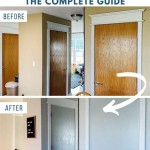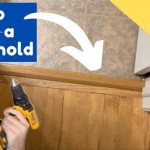How To Repair Car Interior Door Trim Molding
Interior door trim molding, while seemingly insignificant, plays a crucial role in both the aesthetics and functionality of a vehicle's cabin. It conceals wiring, provides insulation against noise and weather, and contributes to the overall interior design. Damage to this trim, whether from impacts, wear and tear, or improper removal, can detract from the vehicle's appearance and potentially compromise its functionality. Fortunately, many repairs can be carried out with readily available tools and materials.
Assessing the Damage
Before undertaking any repair, it’s essential to thoroughly assess the extent of the damage. This assessment dictates the necessary repair strategy. Different types of damage require different approaches.
- Identify the material: Determine if the trim is made of plastic, vinyl, or another material. This identification informs the appropriate adhesives and repair compounds.
- Locate the damage: Pinpoint the precise areas requiring attention. This may involve cracks, scratches, dents, or broken clips.
- Determine the severity: Evaluate the depth and extent of the damage to select the most effective repair method.
Gathering Necessary Tools and Materials
Having the correct tools and materials on hand ensures a smooth and efficient repair process. The required items may vary depending on the specific damage and the type of trim.
- Adhesive: Choose an adhesive appropriate for the trim material. Consider specialized plastic or vinyl adhesives for best results.
- Cleaning solution: A suitable cleaning solution removes dirt, grease, and wax, ensuring proper adhesion of repair materials.
- Trim removal tools: These tools help safely detach the trim without causing further damage.
- Filler or putty: Use filler or putty to address cracks, dents, and holes. Ensure compatibility with the trim material.
- Sandpaper: Sandpaper smooths repaired areas and prepares the surface for painting or refinishing.
- Paint or dye: If necessary, select a matching paint or dye to restore the original color of the trim.
- Masking tape: Masking tape protects surrounding areas during painting or adhesive application.
Repairing Cracks and Scratches
Minor cracks and scratches can often be addressed without removing the trim.
- Clean the area: Thoroughly clean the damaged area with a suitable cleaning solution.
- Apply filler: Carefully apply a small amount of filler or putty to the crack or scratch, ensuring it fills the damaged area completely.
- Sand the area: Once the filler dries, sand the area smooth using fine-grit sandpaper.
- Apply paint or dye (if needed): Touch up the repaired area with matching paint or dye if necessary.
Repairing Dents
Dents in plastic trim can sometimes be repaired using heat. Exercise caution to avoid melting or warping the trim.
- Apply heat: Carefully apply heat to the dented area using a heat gun or hairdryer. Monitor the plastic closely to prevent overheating.
- Shape the trim: As the plastic softens, gently reshape the dented area using a blunt tool or your fingers.
- Cool and inspect: Allow the plastic to cool completely and inspect the repair. Repeat the process if necessary.
Repairing Broken Clips
Broken clips often require removing the trim panel for proper repair or replacement.
- Remove the trim panel: Carefully detach the trim panel using appropriate trim removal tools.
- Replace broken clips: Replace broken clips with new ones, ensuring a secure fit.
- Reinstall the trim panel: Reattach the trim panel, ensuring all clips are properly engaged.
Addressing Larger Damage
Extensive damage or warping may necessitate replacing the entire trim piece.
- Obtain a replacement trim piece: Purchase a replacement trim piece from a dealership or automotive parts supplier.
- Remove the damaged trim: Carefully remove the damaged trim panel.
- Install the new trim: Install the new trim piece, ensuring proper alignment and secure fastening.
Preventing Future Damage
While repairs can restore damaged trim, preventative measures can help avoid future issues.
- Careful entry and exit: Avoid bumping or scraping the trim when entering or exiting the vehicle.
- Proper cargo handling: Secure cargo to prevent it from shifting and impacting the door trim during transport.
- Regular cleaning: Regularly clean the interior trim to remove dirt and grime, which can contribute to wear and tear.
Professional Repair
For complex damage or if you are uncomfortable performing repairs yourself, seeking professional assistance is recommended. Automotive upholstery shops and body repair specialists possess the expertise and equipment to handle complex trim repairs effectively.
- Consult a professional: Contact a reputable automotive upholstery shop or body repair specialist.
- Obtain a quote: Request a detailed quote outlining the scope of the repair and associated costs.
- Schedule the repair: Schedule the repair at a convenient time.

How To Fix Scratched Interior Panels In Your Car Holts
Interior Trim Snapped Off Bmw 3 Series And 4 Forum F30 F32 F30post

Easy Ways To Repair Loose Car Door Panel Upholstery 11 Steps

Car Door Panel Paint Big Changes For Little Dollars Colorbond

Fabric Falling Off A Door Trim Panel Repair

Multifunctional Car Door Trim And Molding Remover Perfect For Furniture Repair 15 53 Pic Au

Door Panel Repair With Bondo Bumper Napa Blog

How To Fix Exterior Door Trim On Car For

Interior Trim Work Basics Diy

Interior Trim Repair How To Fix Damaged And Moldings Keller Home Improvement Tips
Related Posts








